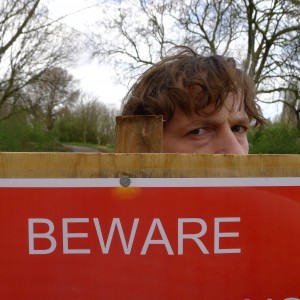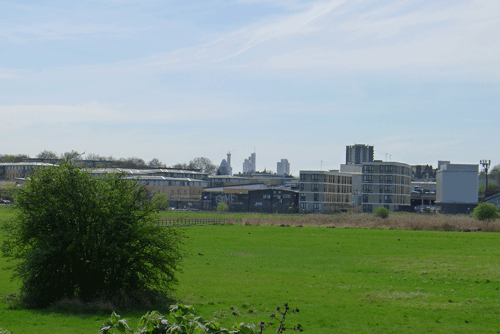In creating the Marshman Chronicles Gareth Rees hasn’t just put together a blog, he has created a world. A world of strange sights and sounds and fascinating people. A world inhabited by ghosts of the past, present and future. A strange world that is commonly known as Hackney and Walthamstow Marshes.
Gareth Rees is The Marshman and his website defies categorisation or description, which is a bit of a bugger when you’re trying to review it. Gareth vey kindly agreed to be interviewed by Psychogeographic Review, so it’s probably best left to him to give you a flavour of the world of The Marshman.
Bobby Seal: Before you go for one of your walks on the marsh do you plan a route or
is it a case of just drifting as the fancy takes you?
Gareth Rees: The dog needs two walks of about 40 minutes each day according to dog experts, vets and something I read somewhere once. I can’t be bothered with that, so I take him out on one big marsh trek each day. Coincidentally, it takes about an hour and a half to walk a circuit of Hackney & Walthamstow Marshes. So I take the same route every day, with minor variations. I might go anti-clockwise. I might cut across the marshes in diagonals. I might circle a smaller area, like the filter beds, a few times, taking pictures. Sometimes I’ll get into conversation with someone and drift along with them. But ultimately it’s the same route, more or less. My walks are like a good intelligent techno track. Lengthy, repetitive with the interest found in minor shifts, additions and omissions.
In my first few months exploring the marsh, back in 2008, it was a genuine derive. I’d no idea the marshes even existed. I’d got married, moved from Dalston to Clapton, my wife became pregnant and I’d given up a large part of my social life. So I bought a dog. And the thing about a puppy is you can only take them on short walks at first. So for a while I’d walk to the bottom of Millfields Park and wonder where the people were disappearing to, and why they came back so muddy and ruddy-looking, like they’d discovered a portal to the Yorkshire moors or something. When the dog was a bit stronger I crossed onto the marshes. I had no map or preconception. I’d read nothing about it. I wasn’t on social media. None of my friends knew about this place. It was a completely blank canvas. Each day I’d go a little deeper, discover something new, then back home with the dog. This strange canine conditioning meant I really savoured the discover and – for a while – every dog walk was a new and bizarre adventure.
* * *
BS: Hackney & Walthamstow Marshes, is it a physical place or a state of mind?
GR: The area I walk isn’t technically a unified place, but it has natural orders created by the topography. The Warwick reservoirs form its northern border. The A12 is its southern border. Its western line is the Lee Navigation – a canal that runs from North London down to the Thames estuary. The eastern border is formed at the north end by the ossified spine of an old aqueduct and at the south end by the river Lea, a remnant of the original waterway.
Within this border can be found Walthamstow Marsh, original boggy marshland surrounded by flooded ditches, bristling with rushes; Leyton Marsh, a drained green space; Middlesex Filter beds, an abandoned water treatment plant which now a nature reserve; Hackney Marsh, vast green network of football pitches ringed with trees; and Wick Woodland a dense patch of trees beneath the A12.
That’s the physical place. But anyone who read my Marshman Chronicles will know that I have a personal take on the environment. My vision of the marshes is an interpretation, not an objective reality that every visitor will necessarily share.
* * *
BS: Marshman Chronicles seems to be increasingly a vehicle for marsh-inspired fiction. Was that a deliberate strategy, or something more organic?
GR: I’ve been writing fiction since I was 6 years old, so it was probably inevitable that it would seep into my blog. Sometimes fiction is a better way of expressing a truth, especially in a liminal place where the facts aren’t clear. But this wasn’t planned. The marsh has so many stories to tell. I’ve never been so inundated with ideas and inspiration in my life, and that includes travelling for a year across South America and Central America when I was 29.
* * *
BS: Do you see your writing as being part of any kind of tradition or system of analysis? I have in mind a host of writers through from Richard Jefferies to Iain Sinclair, but also film directors like Patrick Keiller.
GR: Not really. I’d not heard of Ian Sinclair before I started writing about the marshes, and I can’t say I’m a massive fan, though I find him interesting. My biggest influences are the experimental British writer BS Johnson, and Henry Miller.
This project isn’t intentionally psychogeographical. I know it can be seen as such, but basically I am a bloke walking his dog and writing about it. I’ve no system of analysis. I’m not sure if I even analyse at all. The whole thing is an organic experiment. It’s a labour of love. This is writing I do for fun in my spare time. So I impose no rules or conditions on myself other than “Do What Thou Will Shall Be The Whole of the Law”. Occasionally I pick up on tiny details – the types of rubbish lying around for instance – and run with an idea. Other times I’ll tell a story based on fact. Other times I’ll make up a story and have zombies dragging themselves from the River Lea.
If you look at my early blog posts they were just descriptions of various locations on the marsh, written by a slightly angry man with a new baby and sleep deprivation. The early stuff is really forced, like I’m trying to create a ‘marshworld’. It’s a bit cringeworthy. I’ve had to go back and tweak some of it out of annoyance with myself. I think I was trying to tag the place – impose my will on it. Over the months of really properly looking at the marshes and understanding their relationship with London and I stopped trying to impose my will and let the environment tell the story.
BS: Turning to your work with music, this whole area of meshing mixes of music with landscape is absolutely fascinating. Is it a case of the one helping the listener interpret the other, or is that too simplistic a view?
GR: Quite often, depending on my mood, I’ll take music onto the marshes. My house is so hectic with two children that if I want to listen properly to a new album I have to take it outside on my iPod. But what happened quite early on was that I’d be listening to a piece and the sounds of the marsh would seep in and blend, or jar, or do something transformative to the mix. Trains, distant drills, crow caws, a child’s shout, alarms, helicopters, humming electricity lines… sometimes I would have to take my headphones off to work out what was on the track and what was outside. Other times the music would almost perfectly match the environment and somehow the sights around me would enhance the music I was hearing. I call of these ‘soundchronicities’ – a unique, unrepeatable moment in time where music and environment harmonise or discord in an affecting way. It happens totally in your own head and it’s usually unexplainable in words, which is what good music should be. Admittedly it works best with techno, electro, dub, ambient, hauntological stuff, drone, early electronics, old library tracks, obscure horror soundtracks field recording-based music. I started creating mixtapes based on the sort of music that works well with this and putting them on my website. I even started reviewing albums based on how they affected, or were affected by, the walk.
* * *
BS: Are you sticking around in East London during the Olympics? What are your fears for the post-Olympic period?
GR: Yes I am, because I’ve nothing better to do. I’ve no fears except the one about the earth ultimately ending up as a fireball being swallowed up by the sun. The city is in constant flux, it warps and changes, communities die, buildings go up, buildings come down. Ambitions and dreams become ruins, then those ruins become dreams – that’s what the marshes are about. The whole of the area I walk is littered with technological advances and industrial scars – the canals, the old aqueduct, the reservoir, the filter beds, the derelict warehouses, the bomb rubble that drains Hackney marsh, the Victorian railway bridges… these are all ‘developments’ and they’re what make the place magical and inspirational. Once day someone like me will be walking round the abandoned overgrown Olympic Park thinking “this is great, I am so glad this is here, I can’t believe they want to develop this, it’s perfect”. We have to let go of time. It’s not ours to keep.
* * *
BS: We can all find wonderful, joyful, troubling liminal spaces a bit like Hackney Marshes near to where we happen to live. What advice do you have for any aspiring marshmen or women out there?
GR: If you stick at it, even the most boring place should begin to bring results. It’s all about deep looking, and that can only happen if you give it time and you keep going back, spotting those tiny details. I learned this by accident, but I think it’s true. It’s the little things – the woman in the odd hat you keep seeing on a Tuesday, the packet of pills in the grass verge, the way shadows transform a pathway, the odd small that drifts in at 5 o’clock, the way a pylon sometimes hum, the odd concrete block that shouldn’t be there… try and work out the connections and, hey presto, you’ve a story to tell.
* * *
BS: Finally, does Hendrix have anything he wants to add to the conversation?
GR: He probably wants to know if you’ll give him some dinner. I’ll tell you a weird thing about Hendrix and his role… there’s this couple who walk their dog, who I’ve spoken to a few times. The other day I was on the marsh and didn’t have Hendrix with me. They completely blanked me, just walked past without even a nod. I don’t think they recognised me without a dog. I don’t know what that means, but it’s interesting, probably.
* * *
BS: Gareth, thank you so much for being so generous with your time and helpful with your insights.
Photographs courtesy of The Marshman Chronicles
Map courtesy of OpenStreetMap


